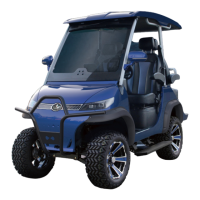WHEELS & TIRES
Be familiar with vehicle features before attempting any operations.
D3 Lifted User’s Manual Page38.
1
2
DO NOT OVER INFLATE THE TIRES. EXCESS PRESSURE CAN CAUSE THE TIRE
EXPLODE.
TO DECREASE THE RISK OF TIRE EXPLOSION, ADD SMALL AMOUNTS OF AIR TO THE
TIRE AT INTERVALS TO SEAT THE TIRE BEADS. OVER INFLATION OF SMALL TIRES
CAN OCCURS IN A FEW SECONDS.
PROTECT FACE AND EYES WHEN REMOVING THE TIRE VALVE CORE.
USE ONLY SOCKETS MADE FOR IMPACT WRENCHES TO DECREASE THE RISK OF
INJURY CAUSED BY A BROKEN SOCKET.
DO NOT USE TIRES THAT HAVE INFLATION PRESSURE LESS THAN THE TIRE
PRESSURE RECOMMENDED.
WHEELS &TIRES
NOTICE
Always follow the cross-sequence pattern when you install the lug nuts to make sure
the wheel is evenly seated against the hub.
Tools list
Lug Wrench, M19..........................1
Impact Wrench..............................1
Impact Socket, M19.......................1
Torque Wrench..............................1
The general recommended tire inflation
pressure is 20 psi, but the tire inflation
pressure can be changed according to the
specific terrain condition.
All four tires must have the same pressure for
the best control qualities. Always put the valve
stem cap back after checking or inflate the
tires.
Use a tire plug to repair small holes in the
thread part of the tires. For large holes or cuts,
replace the whole tire.
1 3
4 2
Cross Sequence
>With the valve stem to the outside of wheel, install
the wheel&tire on the hub with lug nuts.
>Tighten the lug nuts with your fingers in the cross
sequence patten as shown.
>Tighten the lug nuts to 50-85 ft.lbs torque.
>Continue to follow the cross sequence patten until
the correct torque is reached.
WARNING
Lug nut
Tire & Wheel

